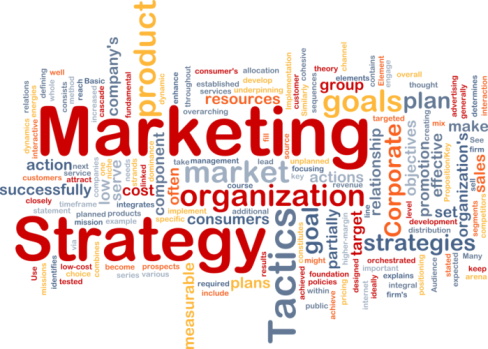In a recent study conducted by KissMetrics.com, visual appearance and color ranked more important to consumers than just about everything else when viewing marketing materials. In fact, ninety-three percent of people who responded to the survey said that visual appearance (which color is a part of) was the most important factor they used when making a purchasing decision. Only six percent said texture, while on percent placed a heavy value on sound and smell.
Color and Marketing: Breaking it Down
Along these same lines, an incredible eighty-five percent of consumers said that color was THE primary reason why they chose to buy a particular product or service. It goes without saying that the right color design is the perfect place to start with your marketing materials.
In terms of your long-term success, one of the most valuable resources that you have available to you is and will always be your brand. It’s something that lives on long after a purchase is made. It’s the narrative and the set of strong, relatable values that are at the heart of your business. Additional studies have shown that the careful use of color can increase brand recognition by up to eighty percent, which, in turn, goes a long way towards increasing consumer confidence at the same time.
But What Do Colors Mean?
However, none of this is to say that your marketing materials should be jam-packed with as many colors as possible. Quite the contrary, in fact. Different colors have all been known to affect people on an emotional and psychological level in a variety of ways. Consider the following:
- Yellow is often associated with optimism and youthful enthusiasm. This is why it’s often used to grab the attention of people like window shoppers.
- Red is almost always associated with a sense of energy and excitement. In fact, red is a great way to create a sense of urgency in your readers (and when used right can even increase their heart rate, too!)
- Black is considered to be very powerful and very sleek, which is why it is usually used to market luxury products.
- Green is normally associated with wealth – which makes perfect sense because money is green. It also happens to be the easiest color for the human eyes to process, which is why green is often used to underline important information in marketing copy.
To that end, it’s important to use different colors depending on exactly what it is you’re trying to accomplish. Are you trying to highlight an upcoming clearance sale and want to create a sense of urgency? Make sure those fliers and posters have as much red on them as possible. Are you trying to attract the attention of a more sophisticated level of clientele, or do you want to positively influence the overall impression that people get when they see your products? Try using as much black as you can.
Color is a powerful tool when used correctly, but it’s important to remember that it is just one of many. But, provided your use of color matches up with both your audience and your long-term objectives, you’ll find that it can be a terrific way to put your campaigns over the top and start generating the types of results you deserve.
It’s well established that print and digital marketing are two entirely different beasts that each require their own unique approaches to reaching their intended audience.
Print Goes Closer
Whereas nobody would argue that digital excels at convenience (since you can essentially reach a person at all times during the day or night), nothing can top print in terms of intimacy. People already believe that receiving actual mail is much more personal than an email containing the same message. On top of that, print provides the ability to physically share a piece of marketing collateral with friends and family members.
According to a recent study commissioned by Martin Lindstrom, however, the benefits of print don’t end there. All of the senses that play a key role when someone has an emotional experience, from touch to sight, to even smell, can all be incorporated into your print campaigns thanks to advancements in technology.
The Science of Senses
In Mr. Lindstrom’s study, it was revealed that if you’re able to engage three or more senses with a piece of print collateral, you have the potential to increase not only brand engagement but also brand awareness by an incredible seventy percent. Many senses, with smell being mentioned in particular, are directly tied to the way the human brain forms memories and how it processes emotions.
Harvard Business School took this research one step further by doing an experiment with, of all things, pencils. Participants in the study were handed two sets of pencils, ones that had been treated to smell particularly nice with tea-tree oil, and ones that were completely untreated. Two weeks later, they were asked to remember specifics about each set of pencils. To the surprise of absolutely no one, the people who had unscented pencils remembered about seventy-three percent less information than those who had the scented pencils.
Using This to Your Advantage
In many ways, this means that while it is always important to focus on how your print collateral looks, you should never fail to take advantage of opportunities to engage a person’s other senses as well. This could include using a thick or textured paper stock to make a direct mail piece feel differently from every other piece of mail a person received that day. As the studies above suggested, it could also include using scented paper or other elements to engage a person’s sense of smell. Not only could this help a person remember your brand, but it could also be a great way to play with your very brand identity.
While print marketing has its advantages over digital, marketers need to work hard to offer a truly unique experience to audiences that they will NOT be able to recreate in the digital world in which we now live. Engaging all of a person’s senses is the perfect way to accomplish precisely that.
The new year often brings with it a time of unabashed change. Regarding visual marketing content, this seems to happen like clockwork every January as a legion of marketing professionals re-ignite their search for the “next big thing” to attract the attention of their target audience. If you want to make sure your 2017 begins as strong as it possibly can, there are some key visual marketing content trends that you need to be aware of.
Integration Continues
According to SmartInsights, one of the biggest upcoming visual content trends to prepare for is nothing new – a further integration of digital and traditional marketing. Only 5% of marketing professionals who responded to a survey say that their campaigns are fully optimized and integrated at this point, but 33% are actively trying to get to that point. Another 33% are currently experimenting with limited integration, and another 12% consider themselves integrated, but not necessarily optimized in the way that they’d like to be. That certainly doesn’t mean they aren’t trying, however.
Never forget: anyone who tells you that you should rely on EITHER print OR digital marketing is probably just trying to sell you something. To reach the widest possible audience, you need to look at them as two important halves of the same whole.
Visual Content Is No Longer a “Single” Technique
In the recent past, marketers tended to look at visual content the same way they looked at social media or video production – all separate techniques that made up a larger marketing campaign. This has been particularly true in terms of people who were doing both print and digital marketing. Visual content was more towards the print side of things, whereas digital skewed towards text-based materials. The wind is changing, though, and it’s clear that visual content no longer serves this purpose. Instead, it must become the very foundation of your larger campaign, the through-line that connects all of your various channels together in a visual way.
Case in point: research has shown that people following directions with both text AND illustrations do an incredible 323% better than those who are only relying on text. When taken together, this means that visual marketing content has a place in every aspect of your larger campaign, from that email you’re about to send out, to new leads, to the breathtaking new flyer you’re about to hand off to USPS. From that perspective, the biggest trend in visual content marketing to prepare for is the very idea that you’ll now be relying heavily on these elements in more places than ever before.
Looking Forward
These are just a few of the key visual marketing content trends that you need to be aware of to prepare better for what awaits you in 2017. One thing is for sure: visual marketing collateral is here to stay, and in many ways, it is more effective than ever. The shape that collateral takes is changing, though, as it should be, and it’s up to you to stay ahead of the curve, so you don’t accidentally find yourself getting left behind.
Many small business owners base decisions on their gut feelings which are comprised of their intuition and experience. However, using gut feelings to make business decisions may not be the best decision-making technique. Many companies are now using analytics and science to make judgment calls. With modern electronics and online tracking, analytics are often available to gather metrics on a myriad of topics. However, you can take business decision-making a step further and design scientific experiments to discover answers to your questions. Here are some suggestions on how you can use the scientific method to learn what decision to make.
Why Use Trial and Error?
Even in our current modern age of computers and mobile technology, too many businesses use trial and error or other decision-making techniques without any evidence of potential results before they get started. Keeping in mind the adage of what happens to people who make assumptions, there are better ways to decide on business matters.
Using the Scientific Method
If you think back to your high school days, you may remember learning about the scientific method. Like many high school students, if you didn’t pursue a career in science, it is likely that you have not thought about the scientific method in recent years. However, business is more like science than you might expect. You can prove and disprove many theories with factual evidence before risking time and money on a new project or campaign. Why should you risk your company income and employees’ paychecks when you can test theories before you take the plunge? If you could predict behavior, you would be able to achieve much more reliable results.
Let’s see how much you remember about the scientific method. The basic method is to create a theory and then set up a scientific experiment to test your theory. You need a test group equally divided into control and experimental subjects.
Setting Up the Experiment
Google is a prime example of a company that tests its theories on a regular basis. They are constantly running tests to see how people react to various changes in their search engine. When they find a particular change that nets the results they want, they then implement the successful change over a larger group of search parameters.
Tests have been run by various companies to answer questions such as these:
Do lobster tanks increase lobster sales at Food Lion supermarkets?
Do eBay users bid higher in auctions when they can pay by credit card?
Do Subway promotions on low-fat sandwiches increase sandwich sales?
Does a Toronto-Dominion branch get significantly more deposits when open 60 hours a week compared with 40? (from https://hbr.org/2009/02/how-to-design-smart-business-experiments)
When Tests Do Not Work
Testing does not work in all situations. You have to have a large enough collection of data to learn anything significant. However, when you do have enough data to create a test, testing will give you measurable and repeatable results. According to the Harvard Business Review,
“Whether in marketing, store or branch location analysis, or website design, the most reliable insights relate to the potential impact and value of tactical changes: a new store format, for example, or marketing promotion or service process.”
If you have a situation with specific, measurable results, instead of guessing the outcome and taking the risk, create a test that will give you a valid answer and confidence in your investment.
As a business leader, one of the core requirements of your job is to make sure that you’re bringing out the absolute best in your team at all times. Every employee working under you not only needs to excel on their own terms but must also be contributing towards the larger whole at the same time. Having quiet, introverted employees can certainly make this difficult, but therein lies the challenge. If you want to use your leadership skills to bring out the best from your introverted employees, you’ll certainly want to keep a few key things in mind.
Work on Your Pace
One of the biggest mistakes you can make in terms of dealing with introverted employees is trying to force them to adapt to the way you like to work. Introverted employees typically don’t like fast-paced, high-stress situations. They need time to think, to plan, and to ultimately prepare for the task ahead. Part of the way you can help bring out the best in these employees involves embracing this idea wherever possible.
Say you’ve got a big meeting coming up and you know that an introverted employee will need to contribute as much as possible. Instead of springing this on them at the last minute, let them know as soon as possible. Give them time to get their thoughts straight and make sure you give them a clear, actionable agenda to work from. If you allow them to build up to the meeting, you’ll find that they’ll be much more engaged than you probably thought they would.
Acknowledge Accomplishments
One of the most important things to keep in mind about introverted employees is that they will rarely, if ever, take outward pride in their own accomplishments. They typically don’t like attention, even if it’s positive, which means that a lot of the hard work they’ve been doing will likely go unnoticed. As a result, it becomes your job to take pride in those accomplishments for them. If an introverted employee absolutely nails a project, make sure everyone on the team knows it. Make the announcement on their behalf, allowing them to feel great while embracing their personality at the same time. Just make sure you spread the love – all team member accomplishments should be acknowledged equally, both for introverts, extroverts, and everyone in between.
Use Technology to Your Advantage
Another factor to consider about introverted employees ultimately comes down to communication. An introvert doesn’t necessarily like to keep in constant contact either in person or by phone, but luckily, technology has made it easier than ever to adapt to this idea. Utilize virtual communication for projects when possible, either via text messages to your team or instant messaging conversations, e-mail threads and more. This will allow your introverted employees to not only contribute to a larger project but to do so in an environment they feel the most comfortable in.
These are just a few of the ways you can bring out the best from your introverted employees all day, every day. Remember that just because someone is quiet and prefers to work in a solitary environment does NOT mean that they aren’t contributing. In the same way, a loud, boisterous attitude doesn’t make someone a good employee either. Your primary goal is to strike a balance. You need to provide ALL employees, regardless of their personality type, exactly what they need to thrive.
Make no mistake about it: one of the biggest keys that you have regarding remaining competitive in a crowded marketplace isn’t the work that you’re doing, per say. It’s the people who are doing the work in the first place. By attracting top tier talent to your business, you affect the entire enterprise from the top down in a number of positive ways. Thankfully, actually getting the attention of these mythical “perfect” employees is a lot easier than you might think – provided that you keep a few things in mind.
Attracting Talent is One Thing – Keeping Them is Another
Many people believe that attracting top talent to a business is something akin to a sports draft. So long as you throw as much money at a person as possible, they’ll definitely come to work for you, right?
Maybe.
Getting a hugely talented person to work for you is really quite easy. Getting them to stick around is easier said than done. Studies have shown that people are willing to switch jobs not because they’ll make more money in a new position, but because they’ll be happier. According to a report published in the New York Times, when a person’s household income exceeds $75,000 per year, it really does nothing to improve the overall level of satisfaction that they feel. They don’t lead happier, more enjoyable or less stressful lives – at least not as far as money is concerned.
What this means is that if you’re offering a top tier employee $85,000 per year in an environment that they’ll ultimately not fit into versus a competitor who is offering $75,000 per year in a place that they would love to work in, that $10,000 ultimately doesn’t buy you as much leeway as you might think – if it buys you any at all.
Essentially, if you want to remain competitive by attracting top talent to your organization, you have to create the type of organization that top talent actually wants to work for. This means that your company culture needs to be welcoming and enjoyable. Your leadership needs to be more than just people high on the totem pole with fancy job titles – they need to be people worth following. The work that you’re doing needs to be something worth pouring your blood, sweat, and tears into. Whether this means continually rewarding employees for hitting certain productivity goals, profit sharing, a second-to-none benefits package or something else entirely remains to be seen – the answer will vary on a case-by-case basis.
The underlying point is crystal clear, though, – picture the employee you want to attract and make sure that your business is a place where that person might want to work. You essentially do the same thing with your marketing campaigns and buyer personas, so when you start to think of it in those terms it really isn’t that hard at all.
The Snake Eating Its Tail
At that point, attracting top talent to your organization becomes something of a self-fulfilling prophecy. By going out of your way to create the type of company culture and environment that top-tier talent want to work for, you’re in turn creating a better business and ultimately a better product at the exact same time. The competitive advantage that you’ve gained and the quality of the work that you’re turning out then go a long way towards attracting even more hugely talented people to your business, which essentially starts the process all over again.
Making this one decision to shift your focus towards creating the type of business that people can’t help but want to work for creates a snowball effect of positive results for nearly everybody involved. Talented people flock to your organization and don’t even dream of looking anywhere else for a job. Customers become more than satisfied with the work you’re producing as your employees are putting their heart and soul into everything that you do. This, in turn, feeds back into your business by way of increased revenue and profits, creating a situation where literally everyone wins. Doesn’t that sound like the type of environment you’d like to create for yourself?
The new year is a time of many things. Oftentimes, people look at it as a way to get a “fresh start” in their personal lives and work towards the goals they may have lost sight of in the previous year. The same concept can hold true for the world of business, but only if you approach things from the right angle. There are a number of important steps that you should take at the beginning of a new year to make sure that your business is headed in the right direction – both literally and figuratively.
Identify Where the Goal Posts are in the First Place
One of the most important steps to take at the start of any new year involves developing a plan for the days, weeks, and months ahead. Simply put, January is the perfect time to start developing both a short-term and a long-term strategy to identify where you see your company going and, more importantly, how it’s going to get there. During this period, it is always important to develop a list of priorities for you to hit along the way. You’ll also have to assess your own sense of accountability and put a process in place to manage these priorities as time marches on.
Reassess Your View of Your Own Organization
Another key step to take at the start of a new year involves taking a long, hard look at your company as it stands today and compare it both to where you started and where you hope to end up. Businesses change as they mature – this isn’t something that you can avoid. The key is that you should always be changing in a positive way. Where do you stand on January 1 in relation to your goals compared to where you stood in December of the previous year? What are the strengths of your business and how have they changed over time? What are your current weaknesses as they relate to your ultimate strategy and what can you do to turn them into positive attributes in the short-term? This allows you to create a realistic picture of your business as a whole, and more importantly, create a realistic view of the future.
Who Are Your Current Leaders?
In the world of business, leaders aren’t necessarily created – they’re born. If you take a natural leader and drop them into an unfamiliar environment, they will eventually rise to the top. They can’t help it. One of the great opportunities that the new year presents involves looking within and identifying the people who may have proven themselves to be exactly this type of leader during the last year. Key leadership, in relation to these individuals, is of paramount importance when it comes to both creating the type of company culture that you need and setting the tone for the priorities that you will attempt to seize in the next year and beyond. A leader isn’t an asset if you don’t know that they’re there in the first place, so always look for those who have proven themselves to help align your organization with your own strategy and gain valuable insight into the steps you should be taking moving forward.
These are just a few of the important steps that you should be taking at the start of a new year to get your business headed in the right direction. Waning from the intended path is natural, particularly as a company reaches maturity. The new year represents an excellent opportunity to take stock of how far you’ve come and to make sure that you’re still headed in the direction that you hoped you would be when you got into this business in the first place.
When it comes to the marketing materials that you’re putting out into the world, there is nothing more important than the factor at the heart of it all: your message. Ultimately, the best-looking print mailer, poster, or other material in the world won’t mean a thing if you don’t have the clear, concise message in the center of it to back it up. If you’re worried about whether or not your design instincts are getting the better of you, and you are, in fact, diluting your message in your marketing materials, you can use these delightfully simple tips to find out.
Are You Overloading the Reader Visually?
Graphics, interesting font choices, and more can all be great tools to help get your message across to readers – but they should be complimentary, not supplementary. Every element that you use in your materials that is not contributing to your message is only taking away from it – never forget that. If your materials have swayed decidedly in the direction of “a lot of style, very little substance” in that you’re loading them up with tons of bright colors, flashy logos, images and more, there’s a great chance that you could actually be accomplishing the exact opposite of what you set out to. Start designing your materials with your message in mind and then lay everything else around it. Don’t design the best-looking print material you can and THEN try to cram your message in there somewhere.
Does it Take Longer than 30 Seconds to Discover Your Message?
In order to achieve a maximum level of effectiveness, your message needs to be as simple as possible. “This company is the one you can trust.” “This product is the one that can solve your problems.” “This service is the one you need to make your life easier.” These are (admittedly simple) examples of marketing messages that can be identified and absorbed quickly and easily. If it takes longer than 30 seconds for your target audience to realize what you’re trying to say, you’ve probably already lost them. Trust us – you don’t have that kind of time.
Do You Have Enough White Space?
White space is undoubtedly the best friend that you have when it comes to the print marketing materials that you’re designing. People don’t want to read a wall of text to find out what you’re trying to say – they want to be spoken to directly and succinctly. If brevity is the soul of wit, white space is the brevity equivalent when it comes to your marketing message. If you design a particular material and have very little white space left over at the end of the process, the chances are high that you should probably take another look. There are undoubtedly elements, whether graphics or text or something else entirely – that you can drop without harming what you’re trying to say.
Anything that isn’t directly contributing to your marketing message is only serving to take attention away from it, which is absolutely something that you do not want under any circumstances. People shouldn’t have to work to figure out what you’re trying to say – it should be immediately clear. By keeping these few, core tips in mind regardless of the type of material you’re designing, you’ll place yourself in a better position to establish a direct line of communication with your target audience in the exact way that you intended.
Following all the rules leaves a completed checklist. Following your heart achieves a completed you. This quote by author Ray A. Davis may be a bit of an oversimplification, but it carries some significance, too. Some people are attracted to breaking rules and live their lives accordingly. They are typically acknowledged as either highly successful people or scoundrels. But in any case, they are people who choose their own paths instead of following the well-beaten trails of life. Many times they are revered as leaders. However, not everyone is cut out for rule breaking.
This may be the key difference between two very different types of leaders. One is devoted to organizing procedures and processes and directing operations and the systems that make them functional. The other is primarily engaged in creativity and the positive influence of others. As such, these two types are differentiated as managers and visionaries. Some individuals are fortunate enough to have both of these capacities, but most of us, if we are leadership material at all, fall into one of these two categories more so than the other, and that is not a bad thing. The world needs both types of leadership.
Perhaps the most important difference between these two is that one of them is routinely devoted to following the rules, or at least helping to make and institute those rules. The other is largely committed to finding ways to circumvent the same rules, exploring new ground instead of restricting one’s latitude to a structured set of limitations. One follows the rules; the other seeks to break them.
Looking at these two individuals we can see some very clearly defined differences. The one who seems born to be a manager is focused on technical aspects and structural adhesion. She is committed to smoothness in operation and well-practiced efficiency. Everyone usually acknowledges that she is quite good at what she does.
The other is visionary in his approach to problem solving, so his solutions are not always popular. He is, instead, a bit of a maverick. But his ideas can be so very convincing sometimes, usually due to his emotional involvement and vision. In a word, he is passionate, and his passion is contagious. He is an idea factory.
Successful entrepreneur and co-founder of Twitter Jack Dorsey said, “Everyone has an idea. But it’s really about executing the idea and attracting other people to help you work on the idea.The idea for Twitter was amazingly simple. It was also untried. The “idea people” attracted some management types to make it happen…and the rest is history.
Successful organizations usually require both types of leadership, the idea generators and the systems people who build and pattern the formula. Successful World War II general and U.S. President Dwight D. Eisenhower said, Leadership is the art of getting someone else to do something you want done because he wants to do it. That, in a nutshell, is the path of the idea creator, the entrepreneurial genius, the visionary leader who starts the engine and motivates it to keep running.
The running of the engine requires the attention of those most capable of coaxing from it the power that is needed. The engine must be tuned to perfection. Systems experts keep it running and running in the right direction. Without them, the visionary’s idea could easily die on the vine.
True leadership may begin with a breaking of the rules, but it can only truly succeed by virtue of learning one’s real limitations and finding help in those areas of relative weakness. Break the rules to get started, but then find help covering your weaknesses from another kind of leader, and your chance of success is increased.
Even the strongest brands eventually go through some type of an identity crisis. Maybe the audience you’ve been targeting for all these years no longer needs the product or service you offer. Maybe you suffered a bit of a setback from a public relations perspective and are looking for a way to start fresh. Rebranding involves a whole lot more than just putting a new coat of paint on an old house — it’s about getting rid of the old so you can make way for the new in the freshest and most impressive ways possible. If you’re in the process of rebranding or are even considering it, your marketing materials will always play an important role in the proceedings.
What is Rebranding?
At its core, rebranding involves starting out with a new marketing strategy that differentiates your current company identity (or the one you hope to have) from the one you had in the past. A brand new symbol, design, visual aesthetic, and even name can all be employed to help accomplish this goal.
How Can I Rebrand?
To begin the process of rebranding, you must first answer the question, “why are we doing this in the first place?” Once you’ve come up with a concrete answer, you need to always keep that in mind as a goal you hope to achieve. Your answer will dictate every decision you make from here on out.
Are you rebranding in an attempt to appeal to a wider audience? Your marketing materials, the logo you’re using, and even your design need to reflect that. Remember that your marketing materials were originally created with your brand in mind — every element, right down to the font being used in direct mailers, was picked because it accurately reflected the brand you were trying to present to the world at that given moment. If your brand is in the process of changing, there is no element of your marketing too small that won’t need to change along with it.
What Can Branding Do For You?
If you want an example of exactly what a successful rebranding campaign can do for your business, look no further than one of the biggest companies on the face of the Earth: Apple. It’s hard to remember a time when Apple as a corporation was teetering on the edge of bankruptcy. That period wasn’t too long ago, however, and Apple was indeed in dire straits as recently as 1997.
Their successful rebranding took the world by storm when they went from “just another electronics company” that put out products many people considered overpriced, to the hippest, most forward-thinking tech company around. Apple’s rebranding campaign got rid of all the complicated terminology in favor of a simplistic campaign that reflected the products themselves. They focused on rebranding themselves as a company that put out reliable and endlessly classy products that “just worked” and have benefited handsomely from that decision ever since.
Look at rebranding for what it is: an opportunity to start fresh. There’s nothing wrong with rebranding — it is not an admission of failure or defeat. It’s a true chance to reaffirm your corporate identity with your goals and take the world by storm in a way more meaningful and more impactful than ever before.









